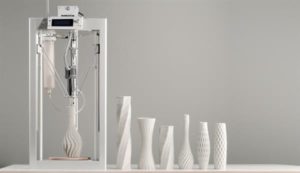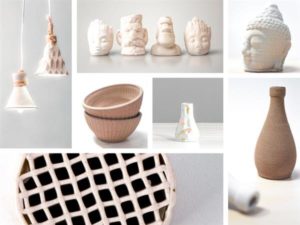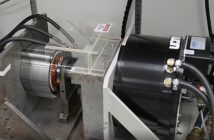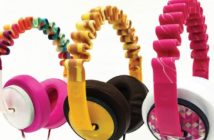 Ceramic has become a popular material in the additive manufacturing world. It’s heat resistant, food safe, relatively strong, and has a look and feel that’s just more pleasant than plastics and polymers. That explains why more companies are 3D printing with ceramic. Now, even makers can join in on the fun because the most affordable ceramic 3D printer yet is being Kickstarted: CERAMBOT.
Ceramic has become a popular material in the additive manufacturing world. It’s heat resistant, food safe, relatively strong, and has a look and feel that’s just more pleasant than plastics and polymers. That explains why more companies are 3D printing with ceramic. Now, even makers can join in on the fun because the most affordable ceramic 3D printer yet is being Kickstarted: CERAMBOT.
CERAMBOT is a delta style 3D printer that extrudes semi-wet clay (or ceramic) that can then be annealed in a kiln. It comes in two kit configurations: a worm-gear plunger (Pro Extruder) or an air extruder kit that requires an air compressor that’s not supplied.

The extruders can also be purchased on their own to be attached to an existing 3D printer, such as a Flashforge, Ultimaker, or Prusa i3. The Pro Extruder can be controlled via a control panel while the air version is manually adjusted with a pressure switch; this could mean that the extrusion rate isn’t determined by the slicing software and therefore starting prints could be a little more tricky.
When we looked at the available ceramic 3D printers on the market, there was a lack of affordable options. In addition to that, the existing models were prohibitively expensive, large and difficult to use. Our goal was to create a printer that would make ceramic 3D printing affordable and easy enough for consumer use.”
.Jony Liu, Founder of CERAMBOT

Industrial linear guide rails provide mechanical accuracy to 0.1mm while nozzles ranging from 0.8 to 1.5mm can extrude layers as thin as 0.4mm and as thick as 2mm. Pro slicers out there will likely get layers under 0.4mm; for comparison, the standard layer thickness on a plastic 3D printer is around 0.175mm.
But while the CERAMBOT may not be able to extrude paper-thin layers, that doesn’t mean it can’t produce a smooth surface finish. Ceramic parts are still pliable after they’ve been 3D printed up until they start drying, so users can smooth and sculpt pieces to be more functional or attractive before they’re hardened in a kiln.

Any clay-like material with a viscosity slightly stiffer than toothpaste can be extruded by the CERAMBOT, even hydrogels. There are even some clays that don’t require baking. A short list of the substrates tested by the development team includes “alumina, silicon carbide, bioceramics: hydroxyapatite (HA), tricalcium phosphate (β-TCP), nano-zirconia.”
The delta design and 1.5mm layers allow for parts to be 3D printed in minutes rather than hours.
The first lucky 100 backers secured their CERAMBOTs with the Pro Extruder for $299, but there are still plenty left between $329 and $369. Air versions are available for as little as $199! There are a few $99 Pro Extruders available as well. The CERAMBOT will greatly benefit researchers, sculptors, interior designers, and any maker that likes to work with lots of materials. The campaign reached its funding goal of $10,000 in a mere six minutes and currently sits at $108,000, so there’s plenty of demand for accessible ceramic 3D printing.
Find More Additive Manufacturing Industry News
on
additivenews.com
- Sources & More information
-
Related article categories:
Industry
Article and featured image:
Source: Cameron, 3Ders.org Nov29, 2018 Cerambot is the most affordable ceramic 3d printer to be kickstarted https://www.3ders.org/articles/20181129-cerambot-is-the-most-affordable-ceramic-3d-printer-to-be-kickstarted-.html, re-edited by João Andrade on Nov30, 2018;




